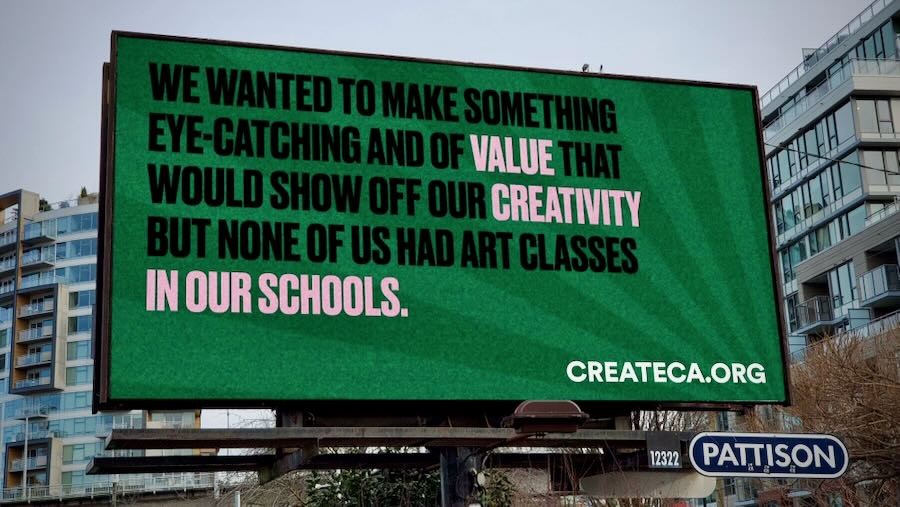Schools have new money for arts education. What should they do now?

Voters committed about $1 Billion to arts education
In November, California voters overwhelmingly passed Prop. 28, an initiative that provides about $1 billion in new ongoing money specifically for arts education. This exciting measure will enable schools to hire new arts staff and create new programs for arts instruction in all PreK-12 public schools.
The task now confronting leaders across the state is to ensure that the measure is implemented as voters intended, with equity front and center. California needs a strong pipeline to identify, train and hire new arts staff.
This investment is timely and important. Mounting evidence shows that arts education boosts young people's educational attainment, bolsters their social and emotional resiliency, and creates more welcoming and engaging school communities. These benefits of arts education are increasingly crucial as we emerge from the pandemic.
|
Overview of California’s new commitment to arts education |
|
|---|---|
|
How much new ongoing money do California public schools get specifically for arts education? |
1% of the amount guaranteed by Prop 98 annually - currently about $1 billion. |
|
How is the money distributed? |
The additional funding from Prop. 28 is disbursed on the basis of enrollment in PreK-12 schools. Of the total, 70% goes to schools based on their share of statewide enrollment. The remaining 30% goes to schools based on their share of all low-income students enrolled statewide. |
|
What must the money be used for? |
The funding must be used for arts education programs. At least 80 percent of the additional funding must be used to hire staff. The rest may be used for training, supplies and materials, and for arts educational partnership programs. All funds must supplement, not supplant, existing arts education programs. |
|
Who decides how the money is spent? |
The intent of Proposition 28 is that funds will reach schools, with an eye to equity. School boards and equity advocates will work to make sure this is how it plays out. |
|
Accountability |
Each year, local governing boards must certify that the funding their schools received for arts education was spent on arts education. |
California’s long-ignored obligation to provide arts education
For decades, California law has required schools to provide arts education in four arts disciplines — music, visual art, dance, and theater. This law was widely ignored, so there is a lot of work to be done. Research commissioned by the Hewlett Foundation from SRI Education and published in September 2022 showed that barely more than one in 10 (11%) of schools across the state are meeting that standard.
The same study confirmed what was widely suspected — access to arts education in California has been fraught with inequities. For example, the percentage of students receiving instruction in the two most common arts disciplines was consistently lower in schools serving low-income students—22% lower for music and 28% lower for visual arts. This is measured by students qualified to receive free or reduced price meals (FRPM).
Closing the arts education gap
By committing to new funding, California voters have put school communities in a position to begin closing the arts education gap. The math included in the proposition provides new money for low-income school communities, a good start to ensuring improved equity in access to arts education for all California students. But it’s only a start.
Policymakers in Sacramento, as well as leaders at County Offices of Education and school districts across the state have an enormous opportunity to eliminate long-standing educational disparities in who benefits from quality, culturally responsive arts education.
Creating California’s future with urgency, not haste
Prop 28 rightly requires that the new funding be used primarily to hire new arts staff. Districts will need to put attention to hiring inspiring educators for the next big step in this journey. These dedicated educators are the heart and soul of successful arts programming in schools. California has made strides in recent years to train new arts educators through the passage of 2016’s Theater and Dance Act (TADA), which reinstated teacher credentialing in those disciplines.
Decades of disinvestment in arts education can’t be overcome in a flash.
Decades of disinvestment in arts education can’t be overcome in a flash. At least for the moment, there simply aren’t enough teachers in California ready to meet the hiring requirements. Further, the current pool of credentialed arts educators - like the overall teaching pool in California and the nation - does not reflect the racial and cultural diversity of California’s public school students. Districts have three years to spend Prop 28 dollars so there is time for proper planning and recruitment of qualified educators.
Meeting this immense need for new arts educators will require creativity and flexibility, both during a transitional period as Prop 28 funds come online for public schools, and over the long term. Crucially, the new roles that are created should be filled by well-prepared, properly compensated creative educators. There is also an opportunity in hiring that Prop 28 will enable the field of arts education to diversify so that more educators look like the students they are teaching, and come from the communities they are serving.
This is a moment worth celebrating. Every student deserves a well-rounded education, including the arts. Investing in arts education will help California rectify historic inequities that have been embedded in our public education system.
Now it’s time to get to work.
 Tom DeCaigny is a respected leader in the areas of arts education, cultural policy and community development. He is currently the Executive Director of Create CA – the largest statewide arts education policy and advocacy organization in the United States. Most recently, Mr. DeCaigny served eight years as the Director of Cultural Affairs for the City & County of San Francisco where he advised three mayors and oversaw the San Francisco Arts Commission (SFAC), a city department with an annual budget of $42 million. At the SFAC, he tripled San Francisco’s annual investment in the cultural sector, advanced racial equity in the City's grantmaking and led several nonprofit affordability initiatives.
Tom DeCaigny is a respected leader in the areas of arts education, cultural policy and community development. He is currently the Executive Director of Create CA – the largest statewide arts education policy and advocacy organization in the United States. Most recently, Mr. DeCaigny served eight years as the Director of Cultural Affairs for the City & County of San Francisco where he advised three mayors and oversaw the San Francisco Arts Commission (SFAC), a city department with an annual budget of $42 million. At the SFAC, he tripled San Francisco’s annual investment in the cultural sector, advanced racial equity in the City's grantmaking and led several nonprofit affordability initiatives.
 Emiko Ono is the Director of Performing Arts at the William and Flora Hewlett Foundation. She leads the foundation's grantmaking for artistic expression and public engagement in the San Francisco Bay Area. With a background in arts administration, Emiko has held various positions in the field, including directing grants and professional development at the Los Angeles County Arts Commission and the Arts Council for Long Beach. She has also contributed to cross-generational leadership in the arts and played a role in the foundation's internal review of diversity and inclusion. Emiko holds degrees from UC Berkeley and Bank Street College of Education.
Emiko Ono is the Director of Performing Arts at the William and Flora Hewlett Foundation. She leads the foundation's grantmaking for artistic expression and public engagement in the San Francisco Bay Area. With a background in arts administration, Emiko has held various positions in the field, including directing grants and professional development at the Los Angeles County Arts Commission and the Arts Council for Long Beach. She has also contributed to cross-generational leadership in the arts and played a role in the foundation's internal review of diversity and inclusion. Emiko holds degrees from UC Berkeley and Bank Street College of Education.
Tags on this post
Funding Student motivation Arts Creativity InitiativesAll Tags
A-G requirements Absences Accountability Accreditation Achievement gap Administrators After school Algebra API Arts Assessment At-risk students Attendance Beacon links Bilingual education Bonds Brain Brown Act Budgets Bullying Burbank Business Career Carol Dweck Categorical funds Catholic schools Certification CHAMP Change Character Education Chart Charter schools Civics Class size CMOs Collective bargaining College Common core Community schools Contest Continuous Improvement Cost of education Counselors Creativity Crossword CSBA CTA Dashboard Data Dialogue District boundaries Districts Diversity Drawing DREAM Act Dyslexia EACH Early childhood Economic growth EdPrezi EdSource EdTech Education foundations Effort Election English learners Equity ESSA Ethnic studies Ethnic studies Evaluation rubric Expanded Learning Facilities Fake News Federal Federal policy Funding Gifted Graduation rates Grit Health Help Wanted History Home schools Homeless students Homework Hours of opportunity Humanities Independence Day Indignation Infrastructure Initiatives International Jargon Khan Academy Kindergarten LCAP LCFF Leaderboard Leadership Learning Litigation Lobbyists Local control Local funding Local governance Lottery Magnet schools Map Math Media Mental Health Mindfulness Mindset Myth Myths NAEP National comparisons NCLB Nutrition Pandemic Parcel taxes Parent Engagement Parent Leader Guide Parents peanut butter Pedagogy Pensions personalized Philanthropy PISA Planning Policy Politics population Poverty Preschool Prezi Private schools Prize Project-based learning Prop 13 Prop 98 Property taxes PTA Purpose of education puzzle Quality Race Rating Schools Reading Recruiting teachers Reform Religious education Religious schools Research Retaining teachers Rigor School board School choice School Climate School Closures Science Serrano vs Priest Sex Ed Site Map Sleep Social-emotional learning Song Special ed Spending SPSA Standards Strike STRS Student motivation Student voice Success Suicide Summer Superintendent Suspensions Talent Teacher pay Teacher shortage Teachers Technology Technology in education Template Test scores Tests Time in school Time on task Trump Undocumented Unions Universal education Vaccination Values Vaping Video Volunteering Volunteers Vote Vouchers Winners Year in ReviewSharing is caring!
Password Reset
Search all lesson and blog content here.
Login with Email
We will send your Login Link to your email
address. Click on the link and you will be
logged into Ed100. No more passwords to
remember!














Questions & Comments
To comment or reply, please sign in .
Kelly Penning June 22, 2023 at 9:46 am
Nancy Krop June 21, 2023 at 10:49 am
tamara_hurley June 20, 2023 at 2:04 pm
Prop 28 also specifically states that its funds should be spent at school sites at the direction of the principals. Since most school districts generally don't give school sites complete discretion on spending funds, likely centralized spending of the Block Grant funds, and likely didn't disperse those funds with a formula "based on equity," how many school districts are actually going to comply with Prop 28? And if they don't, what should the stakeholders do?
Create CA July 5, 2023 at 1:50 pm